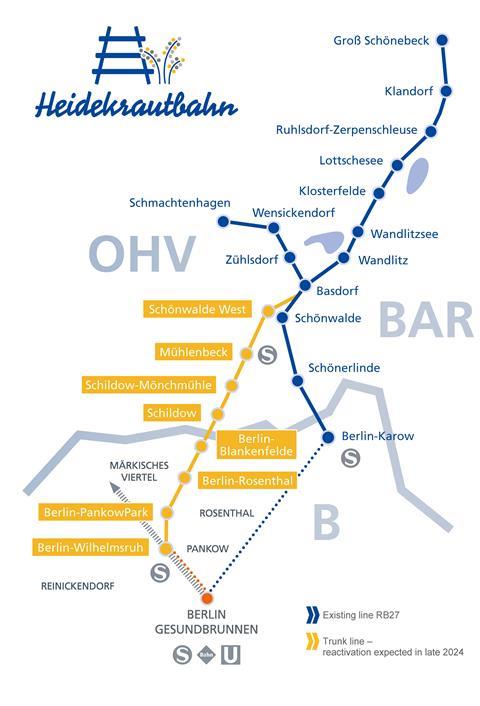Financing new technology, CO2 emission-free mobility

The local public rail service, Heidekrautbahn railway network, will be improved, modernised and expanded.
Heidekrautbahn is a regional railway line in Berlin and Brandenburg, Germany, operated by the Niederbarnimer Eisenbahn (NEB). It serves as an important transport service for the residents of the region. In the upcoming years, the NEB will reactivate the trunk line of the Heidekrautbahn network. The trunk line from northern Berlin to the beautiful Schorfheide region in Brandenburg will be restored to its full length after the line was severely damaged in the Second World War, and the connection was completely severed when the Berlin Wall was built in 1961. Eight new stations from Berlin-Wilhelmsruh to Basdorf in Brandenburg will be opened to passenger service in 2024. The diesel trains currently in use will be replaced by seven low-noise and emission-free regional trains with hydrogen fuel cell drives. The upgrade and expansion of the Heidekrautbahn network are part of a broader effort to improve the transport infrastructure in the region.
Attractive, environmentally friendly, and climate-neutral
The state-of-the-art and innovative Mireo Plus H trains from Siemens Mobility are partly manufactured in Germany. Equipped with a fuel cell drive and a lithium-ion battery, the second-generation hydrogen trains will ensure mobility that is completely CO2-emission free. They will transport commuters to the surrounding area and bring leisure travellers to popular destinations in the area – not only faster and cleaner than ever before, but also climate-neutral in the future.
Hydrogen or fuel cell technology play a key role due to the existing renewable energy supply in the Brandenburg region. To produce the required green hydrogen locally in the region, a hydrogen plant is being built near the Heidekrautbahn railway. The electricity required for this is to be generated entirely within the region from wind and solar energy. It is a joint project: The project developer ENERTRAG is responsible for the construction of the hydrogen plant, a part of the regional, sustainable hydrogen infrastructure. The Niederbarnimer Eisenbahn (NEB) will commission the hydrogen-powered trains on the Heidekrautbahn railway line and Kreiswerke Barnim will construct an H2 train filling station, the other part of the hydrogen infrastructure to ensure the supply of hydrogen at the location of the energy demand.
Running the new trains throughout the Heidekrautbahn network will save around 1.1 million litres of diesel per year, equivalent to potential savings of around 3,310t of CO2 or the CO2 absorption of 120,000 trees when green hydrogen is used.
The upgrade and expansion of the Heidekrautbahn will benefit the residents of the region for years to come and serve as a model for similar projects throughout Germany and beyond, also with regard to its financing solution.

Financing: a challenge
For a bank, pure asset-based finance, i.e. financing based solely on the value of trains as a credit risk, is not yet possible for hydrogen trains. The technical risks and the still barely existing market for these types of trains would make financing too costly. Borrowing from public budgets would increase their debt. Even traditional Public Private Partnership (PPP) financing would entail high financing costs. Meeting all interests while securing low borrowing costs for a long period is an extraordinary challenge for overall financing.
Solution: division of tasks and cooperation between all parties involved
The funds for the overall project consisted of grants from federal and state funds as well as loan financing for the trains of EUR 60 million from KfW IPEX-Bank.
The complexity of the project and the various interests of the parties involved now require a modern and intelligent architecture for the overall project. The relationships between the various partners are crucial here. Financing within this structure reconciles the interests of all parties: manufacturer, buyer, mobility owner, operator and financiers.
- The mobility owner is a project company of Deutsche Anlagen-Leasing (DAL). It limits its functions to ownership, rental and financing. The financing covers the entire project term – from the approximately 2-year construction period to the end of the 25-year operating period.
- Niederbarnimer Eisenbahn (NEB), as the operator, focuses on running the trains for the term of the initial ten-year transport contract, and pays leasing instalments to the project company.
- The states of Berlin and Brandenburg, as transport authorities, award the transport contract and assign parts of the grant payments to the project company. At the same time, they secure the continued use of the trains for a further 15 years and make a commitment to subsequent use.
- KfW IPEX-Bank purchases the assigned grant payments and thus finances the trains at favourable conditions over the entire term.
- The manufacturer Siemens Mobility has security with regard to the payments of the purchase price instalments due.
The key factor in this so-called mobility owner concept is that every participant specialises in their core tasks. The advantages are clear: financing security, favourable conditions in line with municipal needs and the greatest possible transparency for the transport authorities while securing investments in the long term: in this case, hydrogen trains.
New architecture for innovative mobility
The challenges of the mobility transition must be overcome with new technology. Due to the complexity and multidimensional nature of such projects, it makes sense to share the tasks with several cooperation partners – in a structure that meets the requirements of all parties involved. This is where KfW IPEX-Bank contributes its distinct know-how and in-depth market expertise in the mobility sector. In principle, the mobility owner concept can be applied to all public sector investments for public services. The entire project for the new Heidekrautbahn, with all its participants, provides an excellent master plan for this.

















